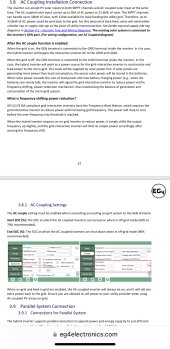Two questions:
1. SolArk has made known its strong preference for AC coupling through the gen port as opposed to a load side sub panel input. EG4 does not address load side coupling on its 18Kpv, as far as I can tell. I’m attaching a shot of the manual dealing with AC coupling, which is not exactly a model of clarity, and says only that the AC coupling should be on the gen port.
My first question is whether the 18Kpv supports load side AC coupling at all. Seems like I remember someone saying it does, sort of. Maybe that it does, but cannot be used for charging, only AC. Can someone from EG4 or Lux clarify this?
2. Second question is about both inverters. Does the ~19-21 kw limit on AC coupling increase in a parallel configuration? That is, if two parallel inverters are handling a combined 35-40 Kw of DC, can they also take, say, a combined 25-35 kw of ac-coupled power too?
Here’s that page from the EG4:
1. SolArk has made known its strong preference for AC coupling through the gen port as opposed to a load side sub panel input. EG4 does not address load side coupling on its 18Kpv, as far as I can tell. I’m attaching a shot of the manual dealing with AC coupling, which is not exactly a model of clarity, and says only that the AC coupling should be on the gen port.
My first question is whether the 18Kpv supports load side AC coupling at all. Seems like I remember someone saying it does, sort of. Maybe that it does, but cannot be used for charging, only AC. Can someone from EG4 or Lux clarify this?
2. Second question is about both inverters. Does the ~19-21 kw limit on AC coupling increase in a parallel configuration? That is, if two parallel inverters are handling a combined 35-40 Kw of DC, can they also take, say, a combined 25-35 kw of ac-coupled power too?
Here’s that page from the EG4:




